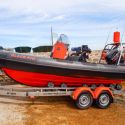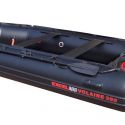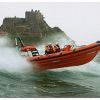 |
 12 October 2023, 06:29
12 October 2023, 06:29
|
#1
|
|
Member
Country: UK - England
Town: Colchester
Length: 5m +
Join Date: Sep 2016
Posts: 3,124
|
Thermostats in small outboards
I tend to always have a thermostat in all of my outboards but I know others remove them and run them with no thermostat. I am here generally talking of outboards up to and including about 20 hp. Ie those typically on SIBs.
In the U.K. generally the water does not get that cold and I suspect the outboard soon warms up. In much colder places this might not be the case.
Given that a thermostat failure can very quickly result in overheating I was wondering if many people run with no thermostat.
Earlier this year we lost what would have been a lovely days boating because of a thermostat failing on my 60 hp mariner
Apart from the outboard not heating up quite as quickly I am wondering what other disadvantages people have found in doing this
__________________
|

|

|
 12 October 2023, 09:11
12 October 2023, 09:11
|
#2
|
|
Member
Country: Other
Town: Principalite d'Chaos
Boat name: The Nashers Revenge!
Make: Windsor Brothers
Length: 6m +
Engine: Optimax 225
MMSI: "Mmmmm SI" she said!
Join Date: Jan 2004
Posts: 4,938
|
In the past I would have agreed, and have been known to remove them myself if I thought they might be causing issues.
However in more recent years I've thought more about how the Thermostat even when open provides an amount of flow restriction.
With the rest of the cooling system being designed around that restriction I worry that volumes and flow rates of coolant in parts of the powerhad may be incorrect with it removed.
__________________
|

|

|
 12 October 2023, 10:34
12 October 2023, 10:34
|
#3
|
|
Member
Country: Ireland
Boat name: 380S
Make: Yamaha
Length: 3m +
Engine: Honda BF15
Join Date: Jun 2023
Posts: 439
|
The thermostat is constantly working within a range so the flow increases/decreases depending on the running temp. I know a lot of people might think it's only working during the warmup phase but that's not actually the case.
Removing it can lead to the engine dropping below normal operating temp for extended periods and that increases the wear. The tolerances are designed around getting up to running temp quickly and maintaining that. The oil viscosity is also affected by the temperature range.
That said, If my plans were held up by a stuck thermostat I'd have no probs removing it to continue on with my adventure, but I wouldn't leave it out indefinitely. If you're giving it the beans a lot then you should be fine, but if it's a leisurely cruise or prolonged idle then you'll be better off having a thermostat in there.
__________________
|

|

|
 12 October 2023, 10:40
12 October 2023, 10:40
|
#4
|
|
RIBnet admin team
Country: UK - England
Town: Cambridgeshire
Boat name: Nimrod II
Make: Aerotec 380
Length: 3m +
Engine: Yam 15 Tohatsu 9.8
Join Date: Nov 2007
Posts: 9,092
|
Spot on description User Name.
The answer is so simple... have a thermostat check on the routine maintenance list. Clean it out and check it opens ok in a pan of water. Don't expect to leave what is probably the original in a 20yr old motor without knowing it's OK. Also gives you a chance to get an idea of the waterways amount of deposits.
__________________
|

|

|
 12 October 2023, 11:37
12 October 2023, 11:37
|
#5
|
|
Member
Country: UK - England
Town: South Yorks
Boat name: Black Pig
Make: Ribcraft
Length: 5m +
Engine: DF140a
MMSI: 235111389
Join Date: Feb 2008
Posts: 12,200
|
Quote:
Originally Posted by User name

The thermostat is constantly working within a range so the flow increases/decreases depending on the running temp. I know a lot of people might think it's only working during the warmup phase but that's not actually the case.
Removing it can lead to the engine dropping below normal operating temp for extended periods and that increases the wear. The tolerances are designed around getting up to running temp quickly and maintaining that. The oil viscosity is also affected by the temperature range.
That said, If my plans were held up by a stuck thermostat I'd have no probs removing it to continue on with my adventure, but I wouldn't leave it out indefinitely. If you're giving it the beans a lot then you should be fine, but if it's a leisurely cruise or prolonged idle then you'll be better off having a thermostat in there.
|
Exactly. If the manufacturers could save a few quid by omitting the ‘stat & the associated pipework/casting/machining, believe me they would. It’s there for a very good reason.
__________________
Rule#2: Never argue with an idiot. He'll drag you down to his level & then beat you with experience.
Rule#3: Tha' can't educate pork.
Rule#4: Don't feed the troll
|

|

|
 12 October 2023, 12:12
12 October 2023, 12:12
|
#6
|
|
Member
Country: UK - England
Town: Farnborough
Boat name: Narcissus
Make: Cobra
Length: 7m +
Engine: Optimax 225
Join Date: Jul 2003
Posts: 2,366
|
The stat also often provides a restriction, even when fully open, so you get a bit more water pressure in the block and avoid hotspots. On the bigger engines (old Merc V6s), if you took the stat out and didn't put a restrictor in, you would quite likely blow the engine.
__________________
|

|

|
 12 October 2023, 12:13
12 October 2023, 12:13
|
#7
|
|
Member
Country: UK - England
Town: Colchester
Length: 5m +
Join Date: Sep 2016
Posts: 3,124
|
Quote:
Originally Posted by User name

The thermostat is constantly working within a range so the flow increases/decreases depending on the running temp. I know a lot of people might think it's only working during the warmup phase but that's not actually the case.
Removing it can lead to the engine dropping below normal operating temp for extended periods and that increases the wear. The tolerances are designed around getting up to running temp quickly and maintaining that. The oil viscosity is also affected by the temperature range.
That said, If my plans were held up by a stuck thermostat I'd have no probs removing it to continue on with my adventure, but I wouldn't leave it out indefinitely. If you're giving it the beans a lot then you should be fine, but if it's a leisurely cruise or prolonged idle then you'll be better off having a thermostat in there.
|
Interesting and excellent description.
I wonder however if in real world use for the average sibber and the amount of time they run their outboard the risks of a failure and the potential danger to the people and damage to the engine caused by an overheat is not a greater peril than any real wear etc that might be caused by not having one in place.
I think also it is important to consider the amount of 'maintenance' your average boater actually does on their outboard.
Be interesting to hear from someone who perhaps has ran stat free for a while
__________________
|

|

|
 12 October 2023, 12:25
12 October 2023, 12:25
|
#8
|
|
Member
Country: UK - England
Town: Farnborough
Boat name: Narcissus
Make: Cobra
Length: 7m +
Engine: Optimax 225
Join Date: Jul 2003
Posts: 2,366
|
Quote:
Originally Posted by Easedalenovice

Be interesting to hear from someone who perhaps has ran stat free for a while
|
Err. See my post above.
Obviously sometimes manufacturers don't quite get it right, but principally, don't use not bothering to maintain your outboard as an excuse to remove the stat. Look after the outboard and keep it in the best nick you can - on a small boat, it's probably your only means to get back home, since rowing several miles is never fun. And I've seen what you look like - Steve Redgrave is probably not a family member, is he....
__________________
|

|

|
 12 October 2023, 13:28
12 October 2023, 13:28
|
#9
|
|
Member
Country: Ireland
Boat name: 380S
Make: Yamaha
Length: 3m +
Engine: Honda BF15
Join Date: Jun 2023
Posts: 439
|
Quote:
Originally Posted by Easedalenovice

Interesting and excellent description.
I wonder however if in real world use for the average sibber and the amount of time they run their outboard the risks of a failure and the potential danger to the people and damage to the engine caused by an overheat is not a greater peril than any real wear etc that might be caused by not having one in place.
I think also it is important to consider the amount of 'maintenance' your average boater actually does on their outboard.
Be interesting to hear from someone who perhaps has ran stat free for a while
|
An overheat will certainly show clear indications that there's something wrong before it eventually cuts and/or locks up, so there's plenty of opportunity for the operator to intervene and shut it down.
The danger of running it too cold though, that's harder to spot, especially to the average recreational user, as it'll tick over just fine but long-term it'll cause a lot more wear than one that is run in the correct temperature window.
My preferred approach is to replace the thermostat at set intervals, regardless of whether they're still working or not. You can also get thermostats that are designed to stick in the open position in the event of a failure, instead of the stuck closed position. It's a good idea to add a simple temp sensor if your outboard doesn't have one. You can get some that show the exact temp, or even just a simple LED that shows when the temp goes above a threshold.
__________________
|

|

|
 12 October 2023, 13:50
12 October 2023, 13:50
|
#10
|
|
Member
Country: UK - England
Town: Colchester
Length: 5m +
Join Date: Sep 2016
Posts: 3,124
|
Quote:
Originally Posted by Matt

Err. See my post above.
Obviously sometimes manufacturers don't quite get it right, but principally, don't use not bothering to maintain your outboard as an excuse to remove the stat. Look after the outboard and keep it in the best nick you can - on a small boat, it's probably your only means to get back home, since rowing several miles is never fun. And I've seen what you look like - Steve Redgrave is probably not a family member, is he....
|
Well curiously my brother and nephew (his son) are very big sportsman and both have more trophies for football and other sports than you could poke a stick at. But I know what you mean and no offence taken as I know it was not intended.
Now maintenance, my belief in if it aint broke don't fix it and the whole word 'Service' is a whole different debate to which there is no correct answer.
Interestingly The person on here who I would argue does the most 'maintenance' of any one else on here was the one who recently had to row home. So real world examples again are what I am interested in rather than theory
__________________
|

|

|
 12 October 2023, 15:22
12 October 2023, 15:22
|
#11
|
|
RIBnet admin team
Country: UK - England
Town: Cambridgeshire
Boat name: Nimrod II
Make: Aerotec 380
Length: 3m +
Engine: Yam 15 Tohatsu 9.8
Join Date: Nov 2007
Posts: 9,092
|
>>The person on here who I would argue does the most 'maintenance' of any one else on here was the one who recently had to row home.
Interesting insight into your character that you would delight in the total failure of my outboard to somehow try and support your theory.
However it's rather the opposite. Info came to light about the seller and his purchase of the outboard that indicated he was very much of your "don't bother" mindset so I bought a ticking time bomb he'd left me and in the time available didn't get far enough in to defuse it before the first run.
Interesting too that you think I'm the person who does the most maintenance on here... you clearly don't bother to read reports of others who carry out some excellent work... particularly some of the superb detail and engineering on RIB rebuilds.
__________________
|

|

|
 12 October 2023, 15:38
12 October 2023, 15:38
|
#12
|
|
Member
Country: UK - England
Town: Farnborough
Boat name: Narcissus
Make: Cobra
Length: 7m +
Engine: Optimax 225
Join Date: Jul 2003
Posts: 2,366
|
Quote:
Originally Posted by Fenlander

Info came to light about the seller and his purchase of the outboard that indicated he was very much of your "don't bother" mindset so I bought a ticking time bomb he'd left me and in the time available didn't get far enough in to defuse it before the first run.
|
I have been on the receiving end of this a few times too. It sucks doesn't it. 
"Full service history" on boats means "when it broke, I paid someone to make it work again".
But these days, I sort of always make the assumption that anything I buy, unless brand new, will need a bit of going over.
On my opti it has immediately got new filters, plugs & gear oil. I do the same on cars to - I always assume needs a service.
Not done the thermostats yet - since if it has had them done before, I can to just do the stats, but if it's not, I will need to replace the housings too - so waiting until the end of the season to see which way I need to go.
There's also a risk in changing stuff. On the engine I built, it has a full flow remote thermostat - so the engine gets full cooling circulation even with the stat closed - it just bypasses the HX. This is great to create a nice even heat across the engine. But, I thought I knew best and decided that this meant I didn't need a water pump bypass since the engine was full flow - so I simplified the system and capped that bypass off.
Oh no.
What actually happened is I blew multiple core plugs out of the engine. How many PSI is needed to blow the core plugs out of an engine - lots & lots.
So in my case, lesson learnt, the hard way. Things are the way they are for a reason - even if you don't know what the reason is. Obvs I do now know the reason for this particular bypass hose. 
__________________
|

|

|
 12 October 2023, 15:42
12 October 2023, 15:42
|
#13
|
|
RIBnet admin team
Country: UK - England
Town: Cambridgeshire
Boat name: Nimrod II
Make: Aerotec 380
Length: 3m +
Engine: Yam 15 Tohatsu 9.8
Join Date: Nov 2007
Posts: 9,092
|
Ahh well all credit to Johnson... even when it went all steam engine on me the core plugs held (I assume it has a couple).
__________________
|

|

|
 12 October 2023, 15:45
12 October 2023, 15:45
|
#14
|
|
Member
Country: UK - England
Town: Farnborough
Boat name: Narcissus
Make: Cobra
Length: 7m +
Engine: Optimax 225
Join Date: Jul 2003
Posts: 2,366
|
Yeah, open cooling systems do have their benefits (this was a closed circuit cooled V8). And bit of a shame the way Evinrude & Johnson engines all ended up, too, they made good engines.
__________________
|

|

|
 |
 Posting Rules
Posting Rules
|
You may not post new threads
You may not post replies
You may not post attachments
You may not edit your posts
HTML code is Off
|
|
|
|
 Recent Discussions
Recent Discussions |
|
|
|
|
|
|
|
|
|
|
|
|
|
|
|
|
|
|
|
|
|
|
|
|
|
|
|
|
|
|
|
|
|










 BLACK PIG
BLACK PIG Piglet
Piglet








